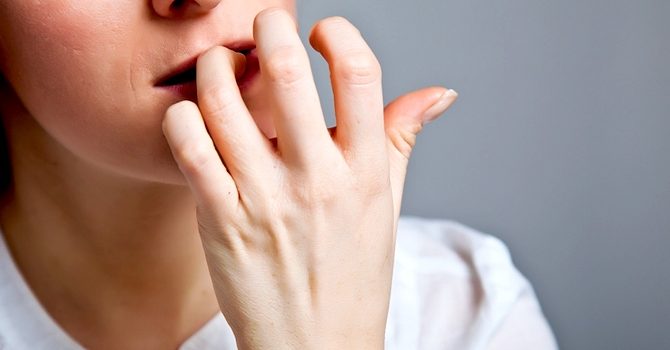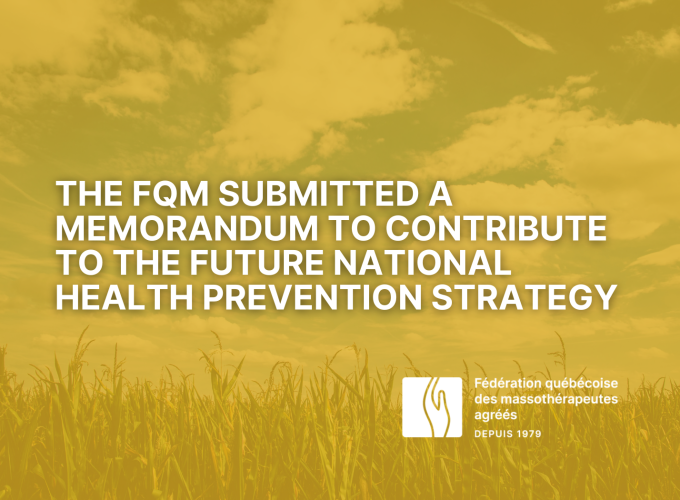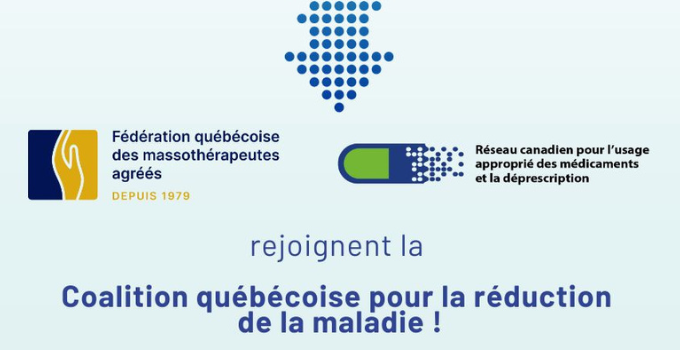 News, Newspaper
News, Newspaper
Massage Therapy and Anxiety
Not only does massage therapy provide many physical benefits, it also contributes to mental and emotional health. Unlike talk therapy, which often explores the emotional dimension from a rational perspective, massage therapy provides a complementary psychophysical approach that can be highly beneficial. This approach involves reprogramming the brain by creating new neural pathways. Gradually, the patient learns to reclaim and retake ownership of their body and desensitize it to physical and psychological pain. Massage therapy goes beyond the skin, muscles and internal organs: it focuses on the entire being and promotes self-awareness and mind-body unification. (1)
Taking charge of your health
If you are experiencing excessive anxiety that has persisted for several months and is out of proportion to real or imagined events, accompanied by symptoms that are behavioural (irritability, hypervigilance, etc.) or physical (shaking, agitation, headaches, trouble breathing, excessive sweating, palpitations, abdominal pain, difficulty sleeping, etc.), it may be helpful to visit your family doctor or another health care professional. Don’t wait until it interferes with your regular activities to make an appointment. A professional can help determine whether you are experiencing an anxiety disorder or another issue and can provide a personalized treatment plan. There are treatments for anxiety disorders that have been proven to be effective. The earlier you speak to your doctor, the more likely it is that these treatments will work for you. In most cases, treatment involving psychotherapy, medication or a combination of the two is highly effective.
According to Dr. Johanne Renaud, medical chief for the youth section of the Douglas Institute’s Depressive Disorders Program in Montréal, massage therapy is helpful for individuals with anxiety disorders. “It goes hand in hand with psychoeducation and healthy habits,” adds Dr. Renaud. Massage therapy has been shown to be very beneficial for trait anxiety (the relatively stable predisposition of certain individuals to experience more frequent and intense anxiety).
According to a study published in American Psychologist, the flagship journal of the American Psychological Association (APA), lifestyle changes may be just as effective as medication or counselling for many mental health conditions, including depression and anxiety.
Scientific research (2)
Massage can help reduce psychological distress, anxiety and trauma by regulating stress hormones. The anxiety-relieving benefits of massage have been observed in numerous clinical trials, meta-analyses and systematic reviews. These studies often focus on specific health conditions, where anxiety is one of the associated symptoms. Several studies have also examined the relaxing properties of massage when dealing with daily situations and events that may induce anxiety.
In a 2008 pilot study, 32 young acutely hospitalized psychiatric patients received massages. Researchers observed a significant reduction in patient anxiety and hostility after each massage session.
In 2009, a pilot study assessed the effectiveness of massage therapy sessions in reducing anxiety in children undergoing chemotherapy and their parents. Four times per week over a two-week period, parents and children either received a massage or were placed in a calm and relaxing room. Massage therapy was shown to be more effective than rest in reducing the children’s heart rate and the children and parents’ anxiety.
In 2010, a systematic review involving 21 studies assessed the effectiveness of massage in reducing physical and psychological stress in seniors (average age of 76). The authors concluded that gentle massage sessions focusing on the back or hands led to higher levels of relaxation. Most importantly, they found that these sessions helped make up for the lack of physical affection that seniors often experience.
In 2004, a meta-analysis of 37 studies involving nine variables and 1,802 participants found that individual massage therapy sessions reduced state anxiety, blood pressure and heart rate, but did not seem to have an immediate effect on negative mood, assessment of pain or cortisol levels.
However, after several massage therapy sessions, a reduction in pain was observed. The most significant effect of massage therapy was a reduction in trait anxiety and depression; the benefits of a series of massage sessions were comparable to those seen in a psychotherapy course of equal duration. (3)
However, while the scientific literature has observed that massage therapy causes biochemical changes (decreased cortisol and increased serotonin and dopamine), massage therapy should not be considered a treatment in itself, but rather a complement to standard treatments.
Massage therapy for individuals with mental illness (4)
Individuals living with mental illness need a safe environment, so make sure to adapt your workspace and movements accordingly. Check whether the person has a support network and will be followed up by a multidisciplinary team. It is not always possible to obtain comprehensive health information from the person themselves; they may be afraid of seeming paranoid, for example, especially since they are not required to disclose a mental health condition. It is therefore advised to speak to the person’s loved ones or health care team for basic information about contraindications to massage and precautions to take. If the person is confused or dazed, you should approach them slowly, from the front, and establish eye contact. Next, greet them by name and introduce yourself. If they respond well, you can also establish gentle, warm physical contact. If not, this should be avoided.
Using short, simple sentences, explain what you are going to do, particularly if it involves physical contact or handling items that belong to the person. Break down the action into multiple steps, if required: “Sit down on the table, slowly; now, lie on your side; now, lie on your back.” Be honest about how much you understand, and don’t pretend you understand if this is not the case.
Use short, affirmative sentences that encourage interaction: “I’m going to place my hands on your shoulders. Is that ok with you? Now I’m going to massage your neck.” Keep an eye out for any signs of enjoyment, displeasure, objection or fear. If you notice any of the last three signs, stop the massage immediately or modify your technique. Confirm that you have received their non-verbal message: “I see that you don’t enjoy it when… that’s ok, I’ll stop.” The most important thing is to preserve the person’s dignity. Showing the person that you respect them is validating. Anchoring is based on safety, while grounding is based on trust. Before touching the person, make sure that you create an atmosphere of safety and trust.
Massage for individuals with mental illness should be performed on a case-by-case and step-by-step basis. It depends on the person’s condition, the stage of their illness, their ability to receive a massage, their decisions, etc.
It is also important to exercise caution by finding out if your client is taking any medications and asking health care staff or Info-Santé (811) about any potential side effects. For example, unlike antipsychotics and antidepressants, benzodiazepines have few peripheral side effects; the observed effects are due to their impact on the central nervous system.
When performed in the right conditions, massage therapy can restore the most basic of human needs, including a sense of safety, confidence, control, self-esteem and intimacy.
Sources
- Dr Michel Lorrain. La place de la massothérapie dans une médecine intégrée. MedActuel, vol. 9, no 11 (2009), p. 28.
- Patrick Barré. Applications thérapeutiques de la massothérapie. (Mai 2011) http://www.passeportsante.net/fr/ Therapies/Guide/Fiche.aspx?doc=massotherapie-th-applications-therapeutiques-de-la-massotherapie
- C.A. Moyer, J. Rounds et al. A meta-analysis of massage theraoy research, Psychol Bull, vol. 130, no 1 (2004), p. 3-18.
- Murielle Primeau, Michèle Guérin. La sécurité et la confiance, la massothérapie des personnes souffrant de maladies mentales. Le Massager, vol. 18 no 1 (mai 2001), p. 11-12.




